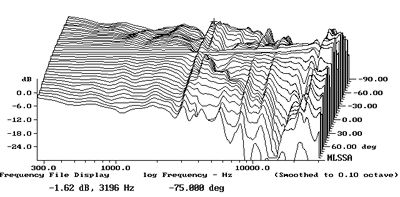| Columns Retired Columns & Blogs |
Red Rose Music R3 loudspeaker Measurements part 2
This graph probably looks worse than it sounds, as the perceived in-room balance will also be strongly affected by the speaker's radiation pattern. The lateral dispersion is shown in fig.5 (actual responses) and fig.6 (the differences between the off-axis plots and the axial response). Although it's hard to see exactly what's going on these graphs, they do suggest that the reverberant field in a smallish room will have more energy in the presence region, which, together with the peak at the top of the woofer's passband, might compensate subjectively for the lack of on-axis energy in the same region. Though fig.5 suggests the tweeter has too much energy in its top two octaves, fig.6 reveals that the driver becomes quite directional above 10kHz—which, again, in a smallish room will work in conjunction with its bipolar dispersion to give a more balanced high-frequency response. In a large room, however, the R3 will tend to sound both bright and lacking in top-octave air, with the brightness accentuated by the relative lack of presence-region energy.

Fig.5 Red Rose R3, lateral response family at 50", from back to front: responses 90 degrees-5 degrees off-axis, reference response on tweeter axis, responses 5 degrees-90 degrees off-axis.

Fig.6 Red Rose R3, lateral response family at 50", normalized to response on tweeter axis, from back to front: differences in response 90 degrees-5 degrees off-axis, reference response, differences in response 5 degrees-90 degrees off-axis.
In the vertical plane (fig.7), there is a little more off-axis energy apparent at the top of the woofer's passband than there is on the tweeter axis. However, a deep suckout in the crossover region appears just below the tweeter axis and more than 20 degrees above that axis. The tweeter's top-octave output also falls off rapidly more than 10 degrees above and below its main axis, meaning that the R3 should be used with a stand that puts its tweeter at the listener's ear height.

Fig.7 Red Rose R3, vertical response family at 50", from back to front: differences in response 45 degrees-5 degrees above tweeter axis, reference response, differences in response 5 degrees-45 degrees below tweeter axis.
In the time domain, the R3's impulse response (not shown) shows some high-frequency ringing, which also results in some raggedness in its step response (fig.8) immediately following the short up/down response of the tweeter and the lazier output of the woofer. That this ringing is due to the ribbon unit can be seen in fig.9, which shows the individual step responses of the tweeter (red trace) and the woofer (blue). It is also apparent that while both drive-units are connected with the same, positive acoustic polarity, the R3 is not time-coherent: the woofer's output follows the tweeter's, and in fact coincides with the subsequent negative-going overshoot of the ribbon's output.

Fig.8 Red Rose R3, step response on tweeter axis at 50" (5ms time window, 30kHz bandwidth).

Fig.9 Red Rose R3, step response of tweeter (red trace) and woofer (blue) on tweeter axis at 50" (5ms time window, 30kHz bandwidth).
The ringing of the ribbon can be seen in the speaker's cumulative spectral-decay or waterfall plot (fig.10) as a ridge of delayed energy at 8kHz, though interestingly, this actually coincides with a sharply defined suckout in the on-axis response. This graph also shows that the peak at the top of the woofer's passband (indicated by the cursor) is also associated with some delayed energy.

Fig.10 Red Rose R3, cumulative spectral-decay plot at 50" (0.15ms risetime).
In his review, Michael comments that "Whatever aberrations show up in John Atkinson's measurements, they have been so skillfully woven into the smooth fabric of the overall sound that I didn't notice them." I take my hat off to speaker designers who choose to use drive-units with disparate radiation patterns. The R3's bipolar tweeter and cone woofer will change the speaker's behavior from omnidirectional dispersion in the bass to quite directional dispersion in the region where it crosses over to the ribbon. Yes, the subjective success with which such a pairing of drivers blends will depend on the designer's skill but to a larger extent than with a conventional design, it will also depend on the size and acoustics of the listener's room. The Red Rose Music R3 seemed to work well in Mikey's room, but as always, home audition of the speaker would be a good idea.—John Atkinson
- Log in or register to post comments




































